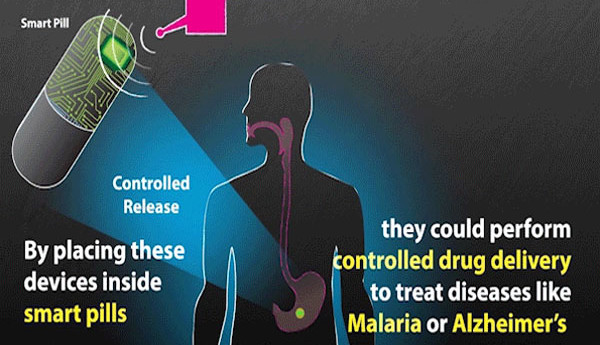Tiny wireless implants
June 05, 2018
on
on

Working in partnership with Brigham and Women's Hospital in the US researchers at MIT, have developed a new way of powering and communicating with devices implanted in the human body. The implants can used to deliver controlled drugs doses and monitor conditions within the body.
The implants are powered by an external source of RF energy. The frequencies used pass through human tissue with little attenuation. In tests with animals, researchers showed that the RF waves can power the devices implanted 10 cm deep in tissue from a distance of one meter. This means the implants operate independently of battery power, giving them a much longer useful lifetime and allows the implants to be made significantly smaller than current-day devices which rely on batteries. Their reduced size allows them to be used for a much wider range of implant applications.
Check out this clip from MIT.
In a study, the researchers tested a prototype the size of a grain of rice and expect that they will get even smaller as development progresses. Medical devices that also can be ingested offer new opportunities for disease diagnosis, monitoring of physiological variables, and precise timing and targeting of medication. In addition, specific vital functions such as movements in the gastrointestinal tract can be monitored.
Sufferers of Parkinson's disease and epilepsy can benefit from deep brain stimulation. These new implants could provide the same treatment wirelessly. A pacemaker implant without batteries could also be built using this technology.
The implants are powered by an external source of RF energy. The frequencies used pass through human tissue with little attenuation. In tests with animals, researchers showed that the RF waves can power the devices implanted 10 cm deep in tissue from a distance of one meter. This means the implants operate independently of battery power, giving them a much longer useful lifetime and allows the implants to be made significantly smaller than current-day devices which rely on batteries. Their reduced size allows them to be used for a much wider range of implant applications.
In a study, the researchers tested a prototype the size of a grain of rice and expect that they will get even smaller as development progresses. Medical devices that also can be ingested offer new opportunities for disease diagnosis, monitoring of physiological variables, and precise timing and targeting of medication. In addition, specific vital functions such as movements in the gastrointestinal tract can be monitored.
Sufferers of Parkinson's disease and epilepsy can benefit from deep brain stimulation. These new implants could provide the same treatment wirelessly. A pacemaker implant without batteries could also be built using this technology.
Read full article
Hide full article


Discussion (1 comment)